| introduction "MUSIC IN MOTION" |
Origins and completion |
main summary |
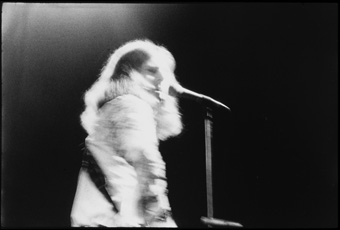 |
First there was a "bad photograph" of Roger McGuinn, shot at the Bottom Line in New York City on September 9, 1975, a blurred image that I didn't use because this type of "mistake" was unacceptable at that time for the musical press. (It is not included in the series "N.Y.C. POP"). Nevertheless, the ex Byrds is perfectly recognizable and the general effect gives a good idea of the concert atmosphere. Thus, the image could not be totally rejected. |
| It was followed, a few months latter by another "bad photograph", shot at a concert of the Head Hunters in the Brooklyn College auditorium. The fast movements of saxophonist Bennie Maupin and the camera's slow shutter speed created an effect that would have been refused by the jazz magazines in 1976. (It is not included in the series "N.Y.C. JAZZ"). But the spirit of the music is clearly expressed here. The image was filed. In 1983, I spent a few days vacationing in the Berkshires, (Massachusetts). At the end of a concert, I photographed the string bass section of the Boston Symphony Orchestra at their summer residence in Tanglewood. The combination of the musicians' diverse movements, my own motion, the type of stage lighting and the limitations of the 35mm camera curtain shutter at slow speeds produced a strange stroboscopic effect. |
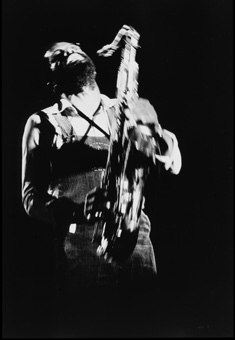 |
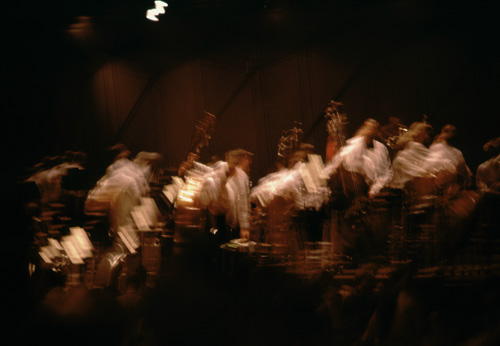
Since 1976, I had expanded my knowledge of studio lighting and had especially experimented on the deconstruction and rendering of motion, first with fashion and illustration photographer Bernard Vidal and then in my own New York studio.
The use of a large format view camera allowed me to precisely combine exposures done with flash and tungsten lighting as well as movements of the subjects and occasionally movements of the camera.
Back to Paris in 1985, I continued my research at the Studios Oasis that I had founded with two other photographers. I imagined the four images of the series "MUSIC IN MOTION" (filed as minuscule sketches on a check book stub) and prepared to put them on film, taking advantage of all the available resources offered by Studios Oasis which had, by then, become the French test studio for the English Bowens lighting equipment.
I had at my disposal a large number of power generators and strobe heads, a good choice of diffusers and accessories, stroboscopes, laser beams for motion detection, a 4000 sq ft shooting area and, above all, a team of motivated assistants.
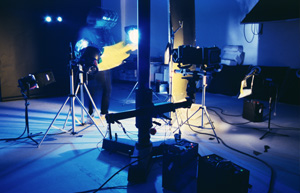 |
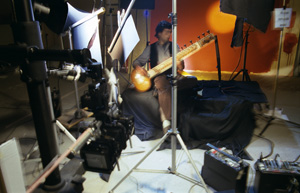 |
In 1989 I produced "POP" and "WORLD" superposing all the exposures in the camera.
Then my creative route took a different turn and the "MUSIC IN MOTION" project was left untouched for the next 17 years.
Meanwhile I spent the largest part of my researching time exploring digital imaging techniques (I started producing digital photographic illustrations on commission as early as 1994. See "PREMIÈRES DE COUV.").
In the spring of 2006, in preparation for an exhibition at the Loches Donjon (Loire Valley) for the Photofolies en Touraine photography Biennale, I committed myself to produce "CLASSIC" and "JAZZ", the two remaining images of the "MUSIC IN MOTION" series. For that series I also composed and produced a musical soundtrack with the help of musicians, experts in each of the styles evocated.
In order to have the possibility to print in a large format and at a high resolution, I captured the different exposures on 4"x 5" reversible film in a 180 sq ft studio, with 3 mono-block strobes, one halogen light and no assistant.
 the photographs composing "CLASSIC"
the photographs composing "CLASSIC"
 the photographs composing "JAZZ"
the photographs composing "JAZZ"
I then combined the different images on the computer, creating what I had imagined at a time when the technical options available were very different.
 computer assisted montage for "CLASSIC"
computer assisted montage for "CLASSIC"
 computer assisted montage for "JAZZ"
computer assisted montage for "JAZZ"
From the beginning in 1988, I had a precise idea of the results I was looking for : to express visually the emotional uniqueness of each type of music evocated. I ,therefore, had no difficulty keeping a visual unity throughout despite the use of the different techniques applied, each with their share of calculation and their share of spontaneity.
Twentieth century photographers and painters attempted to understand motion and questioned our perception of time and space. But one century of creation has now past.
Today, thanks to them, we all enjoy such an array of visual references that images can awaken emotions on a much larger palette.
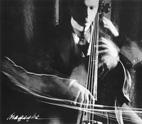 |
When I look at the magnificent photograph of the cellist in motion that the BRAGAGLIA brothers produced in 1913, the image by which I discovered them, I hear a music that they might not have even attempted to take into account. In "MUSIC IN MOTION" movement is just the means not the goal. The musician was their subject, the music has become my sole focus." |